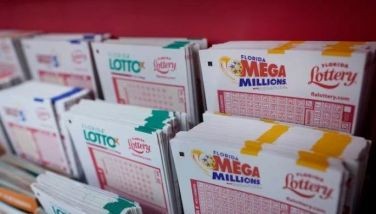The Sandman redux
July 1, 2005 | 12:00am
 (So, there is a Neil Gaiman hoopla sweeping the nation: Everyone and his mother are excited that the creator of The Sandman, one of the best graphic novel series of all time, is coming to Manila on June 9. At least a celebrity is visiting our shores who is not Michael Bublé or half of M2M. How we wish we could confine all those bumbling and tangling politicians inside Gaiman’s magic circle, never to wreak havoc on our beloved nation again. We need more chaos in this country like we need a siphoning tube up our behind. We should thank The Endless our dreams will never be violated by the malevolent forces of this world. Here is a rehashed article about Neil Gaiman’s The Sandman, lost loves, wayward friends, strange worlds, old gods, seasons of mist, and other delicious deliriums. Go ahead, dream away.)
(So, there is a Neil Gaiman hoopla sweeping the nation: Everyone and his mother are excited that the creator of The Sandman, one of the best graphic novel series of all time, is coming to Manila on June 9. At least a celebrity is visiting our shores who is not Michael Bublé or half of M2M. How we wish we could confine all those bumbling and tangling politicians inside Gaiman’s magic circle, never to wreak havoc on our beloved nation again. We need more chaos in this country like we need a siphoning tube up our behind. We should thank The Endless our dreams will never be violated by the malevolent forces of this world. Here is a rehashed article about Neil Gaiman’s The Sandman, lost loves, wayward friends, strange worlds, old gods, seasons of mist, and other delicious deliriums. Go ahead, dream away.)
The dream country is the place we exile ourselves to when reality becomes too unbearably shitty.
First, let us examine what the real world has to offer: idiotic politicians, greedy policemen, deteriorating cities, deteriorating relationships, unsafe streets, callous neighbors, spirit-crushing jobs, money-siphoning relatives, crappy entertainment, diseases, deaths, disintegration and other things that will discourage us from making like Louis Armstrong and scatting, "Papa da pa da… And I think to myself, what a wonderful world." Yeah, think that to yourself, blessed trumpeter.
What about the dreamscape? It is an ever-metamorphosing terrain where the possibilities are endless. We can fly like Peter Pan. Eat like Mama Cass and not get fat like Karen Carpenter. Run like the wind, walk like an Egyptian and fly like an eagle. Make love like John Holmes or Linda Lovelace, and do it infinitely (as if we’ve eaten the balut of a phoenix). Although we have to be wary of occasional bogeymen and trapdoors that will leave us hurtling into infinite abysses and black voids. But I’ll pick black voids over absent lovers, anytime.
Besides, Carl Jung once said dreams provide symbols for us to make sense of the dark and murky unconscious (unreason), which will help us pave the way to self-actualization. We can’t rely solely on the conscious (reason) part of the human psyche to figure out what the f*ck our purpose is in the greater scheme of things. That’s like using just half a telescope to peer into stars, or using just half a tank of water to flush down shit.
Brit writer Neil Gaiman knows this only too well. The writer lets us take comfort in old and new stories of the Dream Lord, a.k.a. Morpheus, Oneiros, Lord Shaper, Nightmare King, Prince of Stories, Monarch of the Sleeping Marches, Lord L’zoril, Kai’ckul, or simply Dream – from The Sandman comic book series created by Gaiman which altered the sphere of comic books in the late ‘80s.
The Sandman stories, with those hallucinogenic Dave McKean covers, suck readers into a weird world where serial killers gather for a convention; where cats dream of world domination; where Lucifer leaves hell to watch God’s sunsets; where Muses are raped and rescued from hacks; where rooks present stories to a parliament; and where a pale-white, reed-thin, morose and melancholy figure keeps watch over a place called The Dreaming – an infinite, ever-changing psychic territory we human beings spend a third of our lives in.
So, what we should do in the coming days is to forget heartaches and bleak political scenarios, get a metaphysical boarding pass and haul our asses straight to the Sandman’s district – home surreal home.
These concepts approximate what Neil Gaiman’s Sandman graphic novels are all about. Note the term approximate. It is foolhardy to try explaining away the whole Sandman universe, which is like putting the history of philosophy onto the head of a pin. Think of this article as a sort of overture to the grand Sandman symphony. Besides, according to Cain (the first murderer and another Sandman character, along with brother Abel), "It’s the mystery that endures, not the explanation." The mystery of Sandman is worth dabbling into, on your own; never always trust a dude with a column, free time and hallucinogenic explanations for everything.
The saga is documented in 10 collections: Preludes & Nocturnes, The Doll’s House, Dream Country, Season of Mists, A Game of You, Fables and Reflections, Brief Lives, World’s End, The Kindly Ones and The Wake.
Trivia No. 1: The first line in the whole Sandman epic is "Wake up, sir…" (from "Sleep of the Just," Preludes & Nocturnes) and the final line is, "You woke up" (from "In Which We Wake," The Wake).
Trivia No. 2: As Neil Gaiman was about to work on his outline for The Sandman, a powerful hurricane swept England – the first one in over 300 years. Trees came down. The power went out. The author wandered around the house in darkness for seven days. Talk about omens. Nice work by the comic-book writer from the great beyond.
The graphic novels revolve around the cosmic, dysfunctional family called The Endless, composed of anthropomorphic personifications of universal forces, immortal projections of fundamental ideas.
"There are seven beings that aren’t gods," as stated in Brief Lives, "who existed before humanity dreamed of gods and will exist after the last god is dead. They are called The Endless. They are the embodiments of (in order of age) Destiny, Death, Dream, Destruction, Desire, Despair and Delirium."
Here is a short and, yes, insufficient description of each one:
Unlike those superheroes that live in a black-and-white, dichotomous world, Dream is beyond good or evil. He traipses over space and time and stories, from one dream to another. A thin, humorless and perpetually-dressed-in-black sovereign, Dream ("a Byronic, moping Goth") does look a bit like The Cure’s Robert Smith and Bauhaus’ Peter Murphy. He "accumulates names to himself like others make friends; but he permits himself few friends."
There is beautiful, sensible and sprightly Death, "who does more than end lives." Dig the deconstruction: Death is not depicted as the scythe-wielding, hooded, bony figure in B-movies or medieval paintings. She was supposed to look like Nico in her "Chelsea Girl" album cover, but Death ended up being based on a girl called Cinnamon – black jeans, black T-shirt, silver ankh, silver necklace and all. In one memorable issue titled "Façade" in Dream Country, Death muses: When the first living thing existed, I was there, waiting. When the last living thing dies, my job will be finished. I’ll put the chairs on the tables, turn on the lights and lock the universe behind me when I leave.
There is whimsical Delirium, "who is poetically flaky and uncommonly wise." She was the Endless formerly known as Delight. "Her eyes are badly matched: one eye is a vivid emerald green, spattered with silver flecks that move; her other eye is vein blue. Who knows what Delirium sees, through her mismatched eyes?"
There is the prodigal Destruction, "who’d rather make omelets than Armageddon." A burly dude who had the wisdom to tell Daniel (Dream’s successor), "Entropy and optimism: the twin forces that make the universe go around."
(Take note: At the end of the saga, the Sandman "died" and the kid Daniel took over The Dreaming. The new god replaced the old god. Probably in keeping with the principles of regeneration, renewal and rebirth – so very Golden Bough.)
There is erotic but tricky Desire, "who lives under our skins." She/he was modeled after the androgynous, Eurythmics-era Annie Lennox. "Never a possession, always the possessor, with skin as pale as smoke, and eyes tawny and sharp as yellow wine: Desire is everything you have ever wanted. Whoever you are. Whatever you are. Everything."
There is Despair, who personifies man’s feelings toward dead-end jobs, treacherous lovers and wretched lives. Gaiman modeled her after a strange, fat, snaggle-toothed naked woman from a book of photographs titled Modern Primitives. She is Desire’s sister and twin. (Not surprising since desiring someone ultimately leads to feeling a sense of despair.) "Many years ago, a sect in what is now Afghanistan declared her a goddess, and proclaimed all empty rooms her sacred places… Despair says little, and is patient."
And then there is blind Destiny, "who reads a book impossibly filled with the past and future history of everything." Having traveled beyond blindness, he is, in Pink Floyd terminology, a "seer of visions." Destiny "smells of dust and the libraries of night. He leaves no footprints. He casts no shadow." Like Richard Ashcroft, according to Noel Gallagher.
The Endlesss are seven beings with seven million stories, seven million predicaments, and seven million different kinds of sadnesses.
Fear slash terror in a handful of dust? No. More like awe in a couple of volumes.
What Gaiman does in the comic book is to juxtapose gods (Greek gods, Norse gods, Egyptian gods, Oriental gods, invented deities, etc.); mythic figures like Lucifer, Kali and Orpheus; historical figures like Augustus Caesar, William Shakespeare, Mark Twain, Marco Polo, Geoffrey Chaucer and Robespierre; and pop figures like an aging John Belushi, Alice Cooper and even Neil Gaiman himself (who attended the Sandman’s wake).
All of them move in a stunning universe of stories – some lifted from old tomes, some based on science fiction or gothic tales (with contemporary tweaking involved in both cases), and some concocted out of thin air by Gaiman.
"We have the right, and the obligation, to tell old stories in our own ways, because they are our stories," explains Gaiman.
Enigmatic rocker Tori Amos says of The Sandman: We don’t remember myths anymore. And what is myth? It’s just truth that has happened and that we’ve forgotten, but that’s still happening now… Neil helps us get in touch with our own memories; he opens a window for us to go in and find ourselves.
That’s as eloquent as Silent All These Years or Cornflake Girl.
One thing hip about The Sandman is its non-linearity. Eras overlap. Characters slip in and out of time. Stories intertwine. Nothing is chronological; everything is permitted. Hy Bender writes in The Sandman Companion that this aesthetic owes much to Milan Kundera who once said, "A novel shouldn’t be like a bicycle race (with scenes cycling their way into the final resolution), but a feast of many courses."
Did the Czech author practice what he preached? He did so in The Unbearable Lightness of Being. The novel ends with Tomas and Tereza dancing, and then afterwards entering a room with a nocturnal butterfly and the strains of piano and violin rising up from below; they are oddly happy. Not with the chronological ending of the couple getting crushed to death under a truck. Thus, in a way, the series of sad events in Unbearable reaches a "happy ending."
Gaiman also practices this in his prose. In "Waiting for the End of the World" (or was it "24 Hours"?) in Preludes & Nocturnes, a caption goes: All Bette’s stories have happy endings. "That’s because she knows where to stop. She’s realized that the real problem with stories – if you keep them going long enough, they always end in death." The author elaborates, "That’s a major theme in Sandman – you get happy endings only by stopping at a certain point."
In Season of Mist, there is a passage dreamed of only by G.K. Chesterton: "…The action of turning a page, of ending a chapter or of shutting a book, did not end a tale. Having admitted that, he would also avow that happy endings were never difficult to find: ‘It is simply a matter of finding a sunny place in a garden, where the light is golden and the grass is soft; somewhere to rest, to stop reading, and to be content.’"
And whether they be dusted-off myths or recycled folk tales – stories in The Sandman resonate with our present-day concerns. So those who think myth no longer plays a part in world ruled by Technology or George W. Bush or Greed or Despair better face the fact that even us puny humans are reliving those big, mythic adventures in our own tiny, pedestrian ways.
This is the thesis of great books like James Joyce’s Ulysses, Joseph Campbell’s The Power of Myth, Carl Jung’s Man and His Symbols, Sir James Frazer’s The Golden Bough, Jorge Luis Borges’ Labyrinths, and, yes, even a "lowly" comic book like The Sandman. How the transcendent co-exists with the banal, without us really knowing it.
Yeah, just like this writer chasing after mechanical dragons (LRT coaches), grappling with evil carriage-drivers (cabbies), wooing muses (she, you, whoever), avoiding the Cyclopes (muggers, snatchers), not falling under the spells of Circe, Scylla and the Sirens (junkies, pushers, fifty-peso whores standing on the corner of Recto and Avenida at 3 in the morning), and enduring the gods on Mount Olympus and their infinite press conferences. Why dream of joining The Extra Challenge when we take on essential, life-affirming quests in secret, every day.
Yes, in certain moments, we are Odysseus, Achilles, Jason, Perseus, Galahad, Arthur, Orpheus, Finn MacCool and other heroes – and that makes for a happy ending despite our shitty stories.
Despite stupid realities…
Even if in dreams only.
This is the part where we find a sunny place in the garden.
Stop.
BrandSpace Articles
<
>

















